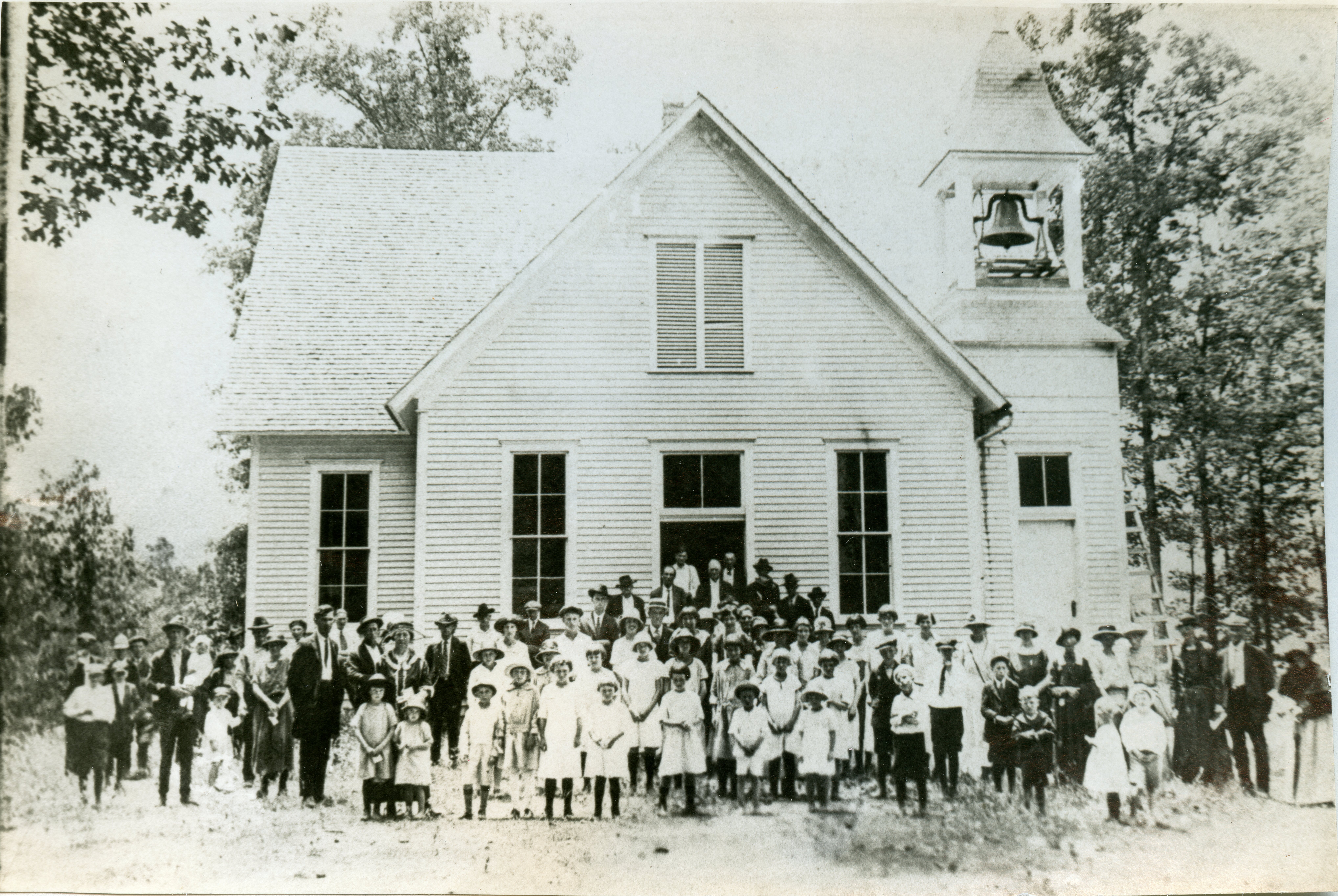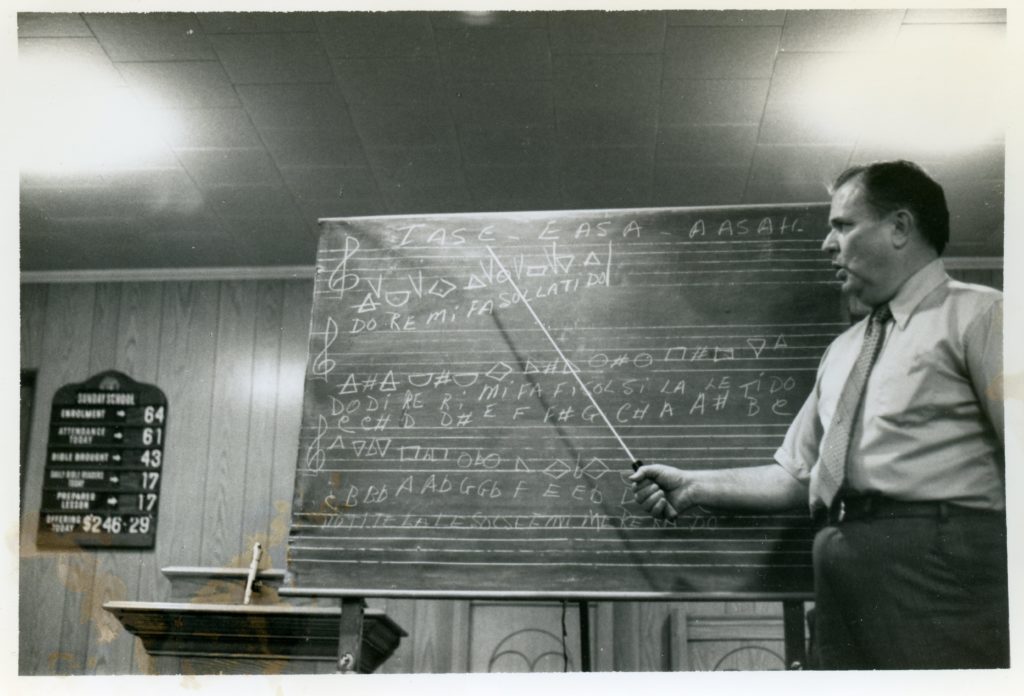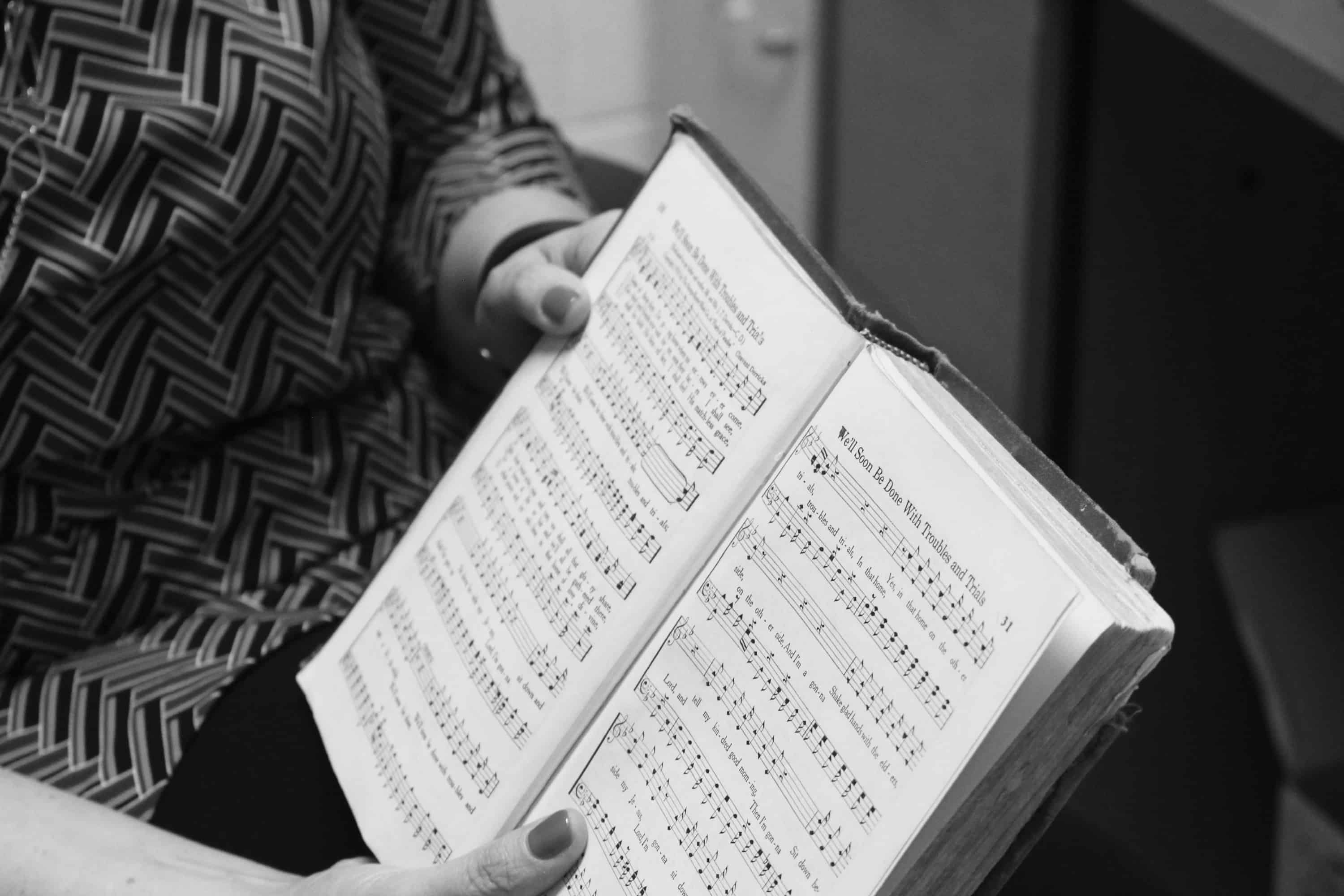In Appalachia, shape-note singing dominated musical and religious groups. Shape-note music, often referred to by the song book used, such as Sacred Harp or Christian Harmony, uses different shapes, like squares, triangles, and diamonds, to represent notes instead of traditional music notes. The shapes enable those who cannot read or cannot read music to understand the melody and flow of the music. Shape-note music also lacks a key signature, making it more approachable to a wider audience. Rather than emphasizing technique and precision like classical music, shape-note focuses on bringing a community of people together in song and worship. To learn shape-note music, people would attend local singing schools, such as the one pictured below. In the mountains, people would come together for singings—a special event where they all sang together for hours at a time. In a rural area dotted with small, independent farms, events such as this were important to building community and relationships.
A few corrections:
- Please note, shape-note singing still thrives worldwide! Visit fasola.org to learn more about these musical gatherings in the modern day.
- Not all shape-note music is “mournful” as described in the podcast, although many of the songs sung by groups in this region of Appalachia were sung in the minor scale

Singing school, ca. 1914
Addie Norton on shape-note singing: “Singing has always been more sacred to me than anything in the world, honey. I don’t know why. There’s nothing in the world that bothers your mind if you love to sing. You’re just as happy and as free as you can be if you’re singing a good gospel song. I love it.”

Hyman Brown teaching shape-note singing.
Learn more about shape-note singing and where to get songbooks here.

Shape-note songbook.
Side One of Christian Harmony cassette released by Foxfire in 1984:
- 16:45-20:00 In That Morning, Walker, Richard Moss leader, 1977
- 20:03-22:04 Sweet Rivers, Moore, Turner Stevens leader, 1979
- 22:07-25:52 Angel Band, Haskill, Laura Boosinger leader, 1980
- 25:56-28:58 Samanthra, Unknown, Laura Boosinger leader, 1980
- 29:04-32:33 Idumea, Wesley/Davidson, Richard and Lula B. Moss leader, 1980
- 32:41-35:20 The Saints Bound for Heaven, King/Walker, David Holt leader 1980
- 35:28-38:08 Time Has Made a Change in Me, Stamps Quartet (SESAC), Richard Moss leader, 1981
The information on this site states that “shape note music is also referred to as sacred harp music”. This is incorrect, or at least, misleading. Shaped note music is NOT sacred harp music, but sacred harp music does use shaped notation. However, what is commonly known as “shaped-note” music uses a 7-tone scale while sacred harp music only uses a 4-tone scale, producing a completely different and distinct sound from the 7-tone, shaped note music.
This is a very significant difference. Please correct your misleading information.
Thank you for your input! We understand your concerns, but to clarify our statement, shape note music is often referred to by the books used by singers–e.g. Sacred Heart or Christian Harmony. The 7-note scale you are referring to is used by Christian Harmony singers, another type of shape note singing. However, Sacred Harp does use shaped-note notation as well. We apologize for not making this statement more clear; again, our use of the term was reflecting how folks in the region refer to it. We will amend this statement. Hope you enjoyed the music!
The “Christian Harmony” singers, as you refer, is a term those of us who sing with the 7-shape notation have mostly never heard and certainly do not use. Fa-sol-la singing, using the four shapes, Fa, sol, la, mi, is referred to as “Sacred Harp” singing. Most of their music is somewhat mournful due to reasons (mathematically & musical) which I don’t have space to address here. The 7-shape system is used by ALL gospel, southern gospel, convention music, etc. throughout the south (including “Appalachia”) and differs from “regular” church music (i.e.hymns, etc.) ONLY in that it uses shapes as opposed to standard notation. The scales, etc. used by 7-shape “systems” or “singers” / “writers” , if you will, are the same scales used in church/sacred music. This statement is NOT true of Sacred Harp music. The scales in Sacred Harp are different. The two systems (Sacred Harp or Fa-Sol-La as it is often called and the 7-Shape System) are very distinct from each other, with the only real similarity being that each uses “shapes”. While these shapes (and their systems) may seem similar, deeper study will show that they have more differences than similarities, producing extremely different music. Churches all over the southern US (including Appalachia) (and some in the north) use the 7-shape system. There is so much more that can be said on the subject to clarify each system, but space prohibits it. Bottom line is, once one learns the intricacies of even one of the systems, it becomes blatantly obvious just how very different and distinct they are. They are 2 very different traditions and most of us in either tradition do not like reading about or hearing the 2 dumped into one category, aka “Shape note singing”. If this topic requires further discussion, I can be reached at the email below.
Thank you so much for this fascinating podcast , I have learned much and want to know more .
Great introduction. Addie Norton got it right. There are lots of videos that can be found n YouTube.com . Search using the using the name of a book. You may also like singing from the New Harp of Columbia, The Social Harp, the Sacred Harp Cooper edition and The Colored Sacred Harp.
Thanks for posting.
Love that you featured this. Richard Moss is my great-great-grandfather, so his family is happy to have heard this. This was the first time I’ve heard a recording of him. Thank you.
So glad you were able to hear him! What a great connection. Thank you for listening.
I was at the Etowah singing when Richard was there. He had a powerful lovely style of singing. He lead Idumea. He also had a quick whit and great personality. There is a collection of his songs at the University of Georgia on tape reels. I wish someone would convert this to a digital format and put it on line for all to enjoy. Richard and his wife lived in Warren, NC. Foxfire sold a tape that had Time has made a change on it.
I enjoyed listening to this! My father read shape notes, though I never learned. We used to spend hours singing at home.
Shaped Note singing is popular here in the UK. I belong to a very small group in East Sussex. With the restrictions due to the virus, we have not met in over a year! Really miss it.
Thanks for posting this. I’m not sure why the intro says “Shape-note music also lacks a key signature, making it more approachable to a wider audience.” That might have been true of the original pieces, but it is no longer true. See these two hymns from Sacred Harp: https://sacredharpbremen.org/32b-distress/ in E Minor and https://sacredharpbremen.org/33t-weeping-savior/ in F# Minor.
Also, that website is an excellent online resource for shape note singing, and it comes from Bremen, Germany: https://sacredharpbremen.org/en/home/
The “About us” info on that site explains its founder’s passion for shape note singing.